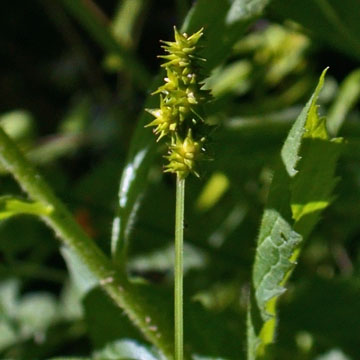

Carex cephaloidea - (image 1 of 3)
Taxonomy
Family: Cyperaceae
Section Phaestoglochin
Habitat
Dry to mesic woods on neutral or calcareous soils.
Associates
Distribution
New Brunswick to MI and MN, south to NJ, OH, and IL.
Morphology
Tufted perennial, 40-80 cm; stems usually rough above, equaling of surpassing the leaves; spikes aggregated into an ovoid or narrowly ovoid head 2-4 cm long; spikes androgynous, subglobose or ovoid; bracts none or setaceous, shorter than the heads; pistillate scales acute or with a very short cusp, scarcely more than half as long as the body of the perigynium; achene lenticular, broadly ovate, the style-base slightly thickened.
Notes
Fruiting June to July
Wetland indicator: FACU
Similar to C. sparganioides but with the spikes more congested at the top of the inflorescence. Very much like C. aggregata which has longer pistillate scales (about as long as the body of the perigynium vs. only about half as long) that are acuminate and cuspidate at the apex (vs. merely acute or with a very short cusp)
References
Gleason, Henry A. and A. Cronquist. 1991. Manual of Vascular Plants of
Northeastern United States and Adjacent Canada. Second Ed.
The New York Botanical Garden. Bronx, NY
|
© Michael Hough 2018 |